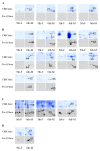Proteomic identification of differentially expressed and phosphorylated proteins in epidermis involved in larval-pupal metamorphosis of Helicoverpa armigera
- PMID: 20003373
- PMCID: PMC2806347
- DOI: 10.1186/1471-2164-10-600
Proteomic identification of differentially expressed and phosphorylated proteins in epidermis involved in larval-pupal metamorphosis of Helicoverpa armigera
Abstract
Background: Metamorphosis is an important process in the life cycle of holometabolous insects and is regulated by insect hormones. During metamorphosis, the epidermis goes through a significant transformation at the biochemical and molecular levels.
Results: To identify proteins and phosphoproteins involved in this process, we separated and compared epidermal protein profiles between feeding larvae and metamorphically committed larvae using two-dimensional gel electrophoresis and Pro-Q Diamond Phosphoprotein Staining. Sixty-one spots showing differential expression and/or phosphorylation were analyzed by mass spectrometry and eighteen proteins were proved related to larval-pupal transformation. Eight of them were further examined at the mRNA level by Reverse Transcription Polymerase Chain Reaction (RT-PCR) and two of them were examined at the protein level by Western blot. Calponin was highly expressed in the metamorphic epidermis and phosphorylated by protein kinase C.
Conclusion: Our results suggest that the expression and phosphorylation of these proteins may play important roles in coordinating the biochemical processes involved in larval-pupal metamorphosis.
Figures





Similar articles
-
De novo characterization of transcriptome and gene expression dynamics in epidermis during the larval-pupal metamorphosis of common cutworm.Insect Biochem Mol Biol. 2013 Sep;43(9):794-808. doi: 10.1016/j.ibmb.2013.06.001. Epub 2013 Jun 22. Insect Biochem Mol Biol. 2013. PMID: 23796435
-
Identification of genes differentially expressed during larval molting and metamorphosis of Helicoverpa armigera.BMC Dev Biol. 2007 Jun 25;7:73. doi: 10.1186/1471-213X-7-73. BMC Dev Biol. 2007. PMID: 17588272 Free PMC article.
-
RNA-seq analysis of gene expression changes in cuticles during the larval-pupal metamorphosis of Plutella xylostella.Comp Biochem Physiol Part D Genomics Proteomics. 2021 Sep;39:100869. doi: 10.1016/j.cbd.2021.100869. Epub 2021 Jun 19. Comp Biochem Physiol Part D Genomics Proteomics. 2021. PMID: 34171685
-
The transcription factor RUNT-like regulates pupal cuticle development via promoting a pupal cuticle protein transcription.PLoS Genet. 2024 Sep 12;20(9):e1011393. doi: 10.1371/journal.pgen.1011393. eCollection 2024 Sep. PLoS Genet. 2024. PMID: 39264939 Free PMC article.
-
Molecular mechanism and evolutional significance of epithelial-mesenchymal interactions in the body- and tail-dependent metamorphic transformation of anuran larval skin.Int Rev Cytol. 2007;260:213-60. doi: 10.1016/S0074-7696(06)60005-3. Int Rev Cytol. 2007. PMID: 17482907 Review.
Cited by
-
Calponin-like Chd64 is partly disordered.PLoS One. 2014 May 7;9(5):e96809. doi: 10.1371/journal.pone.0096809. eCollection 2014. PLoS One. 2014. PMID: 24805353 Free PMC article.
-
Cellular effects of bacterial N-3-Oxo-dodecanoyl-L-Homoserine lactone on the sponge Suberites domuncula (Olivi, 1792): insights into an intimate inter-kingdom dialogue.PLoS One. 2014 May 23;9(5):e97662. doi: 10.1371/journal.pone.0097662. eCollection 2014. PLoS One. 2014. PMID: 24858701 Free PMC article.
-
Phosphoproteome analysis during larval development and metamorphosis in the spionid polychaete Pseudopolydora vexillosa.BMC Dev Biol. 2011 May 25;11:31. doi: 10.1186/1471-213X-11-31. BMC Dev Biol. 2011. PMID: 21612608 Free PMC article.
-
Comparative phosphoproteomic analysis of BR-defective mutant reveals a key role of GhSK13 in regulating cotton fiber development.Sci China Life Sci. 2020 Dec;63(12):1905-1917. doi: 10.1007/s11427-020-1728-9. Epub 2020 Jul 3. Sci China Life Sci. 2020. PMID: 32632733
-
Differential expression of proteins and phosphoproteins during larval metamorphosis of the polychaete Capitella sp. I.Proteome Sci. 2011 Sep 3;9:51. doi: 10.1186/1477-5956-9-51. Proteome Sci. 2011. PMID: 21888661 Free PMC article.
References
Publication types
MeSH terms
Substances
LinkOut - more resources
Full Text Sources

